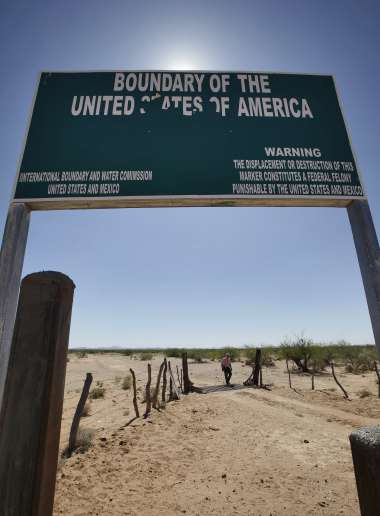Introduction

A barrage of legal and fiscal challenges is sure to dog two executive orders President Trump signed Wednesday that reflect his promises to build a “great wall” and attack cities sympathetic to undocumented residents. On Wednesday, Trump ordered the Department of Homeland Security to begin planning for a 2,000-mile-long U.S.-Mexico wall, as well as the addition of additional border agents, more detention centers and a plan to withhold federal funds from so-called “sanctuary cities.”
The president said his executive orders would restore “rule of law” and control of the border. “What I’m doing is good for the United States,” he said. “It’s also going to be good for Mexico.” But his actions set off angry denunciations from civil rights groups that accuse Trump of scapegoating immigrants by feeding the public only negative portrayals of Mexicans, Muslims and undocumented people generally.
“President Trump made a campaign out of demonizing immigrants and spreading lies…Today, he is poised to use those lies as a cornerstone of public policy, and the consequences are devastating for all of us,” said Marielena Hincapié, Executive Director of the National Immigration Law Center. “These new executive actions are extremist, ineffective and expensive.”
She also said Trump’s rhetoric has put those who “look like” immigrants or Muslims in danger.
The NILC and other organizations—and U.S. business associations as well—have long pushed for compromise immigration solutions that would split apart fewer established families, allow some people to legalize and require U.S. businesses to use electronic checks on work documents, as the Center for Public Integrity has reported. But now civil rights groups are vowing to go to court to challenge Trump’s policies as he rolls them out. Rights advocates say they’re developing lists of lawyers to defend individuals’ access to due process, including those seeking asylum from violent countries, as CPI has reported.
Civil rights groups have also contended that Trump’s rhetoric about “sanctuary cities” is built on myths, including the belief that such cities block federal immigration agents from conducting enforcement. No city can block such enforcement, which is a federal responsibility. The concept of a sanctuary city is loose, with some cities, for example, issuing no more than proclamations that they welcome immigrants and others adopting official policies that prohibit their police officers from quizzing people about immigration status.
While many municipalities say they work with immigration agents on serious crime investigations, multiple chiefs of police argue that involving city cops in quizzing people on their status destroys trust in officers, harms crime-fighting efforts and increases the possibility of discrimination and rights violations. Federal officials and cities and states have long fought over expenses for prolonged holding of suspected undocumented immigrants on “detainer” requests. Some groups, representing residents who’ve been held, argue agents should get warrants for those they’re seeking.
Some cities, like San Francisco, have sparked outcry by declining to hold onto jailed people who don’t have recent violent crime records or for whom federal officials don’t file a warrant. A woman was killed in 2015 by such an undocumented immigrant who was charged with second-degree murder. In his defense, the man said he picked up a gun he said he had found, and it discharged, accidently. San Francisco officials said if federal agents had provided a warrant the man would have been held.
Trump’s plans to build wall could cost as much as $20 billion, according to some experts. Taxpayers would have to foot the bill to get the initiative started, while also paying out for a proposed surge in border agents. Trump said his administration is working on a plan to force Mexico to reimburse the costs of the wall, but Mexican leaders have said repeatedly that they won’t pay for it. Since the early 1990s, the border has been gradually fortified in many stretches, with high fences, some multiple, and tall metal barriers. Construction has continued to fill in some areas that officials deem are priorities.
Homeland Security has also supplemented fencing with sensory devices implanted in the ground, as well as an array of cameras and Border Patrol agents. Remote stretches of river, extremely rough terrain and harsh desert divide the two countries and make constructing and maintaining barriers challenging. As urban areas in California and Texas were fortified in the 1990s, many migrants headed into harsh desert terrain in Arizona, where thousands have perished. Although some fencing—with gates—runs through their Arizona reservation, tribal leaders of the Tohono O’odham Nation west of Tucson say they’ll refuse to allow a solid wall to be built through the 75 miles they control. Landowners and those concerned about environmental damage will also have a say over construction as Trump’s plan moves forward.
Read more in National Security
National Security
Overwhelming majority believe U.S. should remain in controversial arms accord
Trump wants out, says Russia has violated treaty’s terms, but even most Republicans oppose withdrawal.

Join the conversation
Show Comments